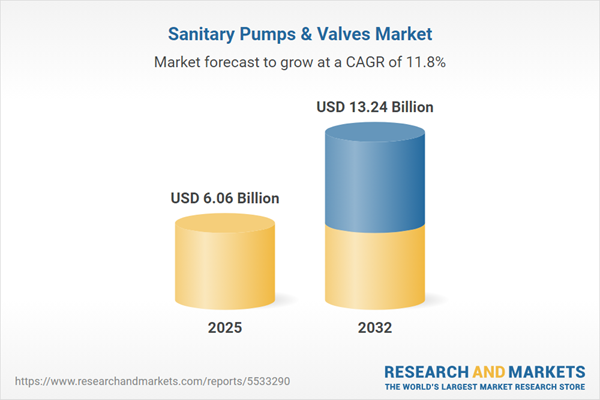Speak directly to the analyst to clarify any post sales queries you may have.
Sanitary pumps and valves are increasingly central to process industries, delivering hygienic fluid handling, regulatory compliance, and efficient system management. The dynamic transformation of the sanitary pumps & valves market is redefining strategic priorities for senior decision-makers worldwide.
Market Snapshot: Sanitary Pumps & Valves Market Growth and Trends
The sanitary pumps & valves market has demonstrated robust momentum, advancing from USD 5.43 billion in 2024 to USD 6.06 billion in 2025 and on track for continued expansion at a CAGR of 11.78%, projected to reach USD 13.24 billion by 2032. Sector growth is driven by evolving hygiene requirements across the food, beverage, pharmaceutical, biotech, and water treatment industries, which increasingly demand contamination-free operations and regulatory traceability. Digital transformation, stringent cleaning protocols, and novel materials are reshaping design, function, and supply chains in this sector.
Scope & Segmentation of the Sanitary Pumps & Valves Market
This comprehensive analysis encompasses the following segments and regional footprints for actionable market insight:
- Pump Types: Axial flow, centrifugal, diaphragm, positive displacement (gear, lobe, piston, plunger, screw), reciprocating (piston, plunger), rotary
- Valve Types: Ball, butterfly, diaphragm, plug
- End Use Industries: Chemical processing, food and beverage, mining, oil and gas, pharmaceutical, power generation, pulp and paper, water and wastewater (drinking water, sewage, industrial effluent)
- Applications: Boiler feed, chemical dosing, hygienic processing, process cooling, slurry handling
- Materials: Alloy steel (carbon, duplex), bronze, cast iron, plastic, stainless steel
- Regional Coverage: Americas (United States, Canada, Mexico, Brazil, Argentina, Chile, Colombia, Peru), Europe, Middle East & Africa (UK, Germany, France, Russia, Italy, Spain, Netherlands, Sweden, Poland, Switzerland, UAE, Saudi Arabia, Qatar, Turkey, Israel, South Africa, Nigeria, Egypt, Kenya), Asia-Pacific (China, India, Japan, Australia, South Korea, Indonesia, Thailand, Malaysia, Singapore, Taiwan)
- Key Companies: Alfa Laval AB, SPX Flow, Inc., GEA Group Aktiengesellschaft, Flowserve Corporation, KSB SE & Co. KGaA, Grundfos Holding A/S, NETZSCH Holding GmbH, Dover Corporation, GEMÜ Gebr. Müller Apparatebau GmbH & Co. KG, Inoxpa S.A.
Key Takeaways for Senior Decision-Makers
- Adoption of smart monitoring, variable frequency drives, and predictive maintenance is advancing operational transparency and reducing downtime across high-value processing lines.
- Material innovations, including antimicrobial coatings and corrosion-resistant alloys, are elevating product lifecycle and total cost efficiency, particularly in regulated sectors like food and pharma.
- Digital transformation through IoT and additive manufacturing enables real-time diagnostics, rapid prototyping, and increased customization, providing competitive differentiation and regulatory readiness.
- Collaborative supply agreements and local manufacturing partnerships buffer organizations against trade volatility and changing tariff landscapes, strengthening supply chain resilience.
- Automated Clean-In-Place (CIP) and Steam-In-Place (SIP) integration streamline compliance with international safety standards and minimize manual intervention in sensitive environments.
Tariff Impact and Supply Chain Strategy
Recent United States trade tariffs on key raw materials, including stainless and alloy steel, have reshaped sourcing and procurement strategies. Suppliers and OEMs are actively diversifying manufacturing hubs and strengthening relationships with domestic partners to optimize costs and qualify for free trade exemptions. Logistics and inventory models are optimized for both duty mitigation and operational continuity, providing flexibility as tariff structures evolve. Longer-term contracts and transparent cost models further solidify collaborative ties between buyers and equipment vendors.
Methodology & Data Sources
The report integrates qualitative findings from industry expert interviews and primary research with quantitative analysis from surveys across procurement, engineering, and operations leaders. Technical whitepapers, financial disclosures, and government filings underpin data reliability. Rigorous validation processes, including statistical modeling and independent peer review, ensure actionable accuracy for senior leaders weighing capital expenditure and procurement choices.
Why This Report Matters for Strategic Decision-Making
- Delivers operationally relevant insight into evolving technology, regulatory compliance, and cost optimization levers specific to sanitary pumps and valves.
- Empowers leaders to benchmark market positioning, identify growth opportunities, and align product portfolios to shifting industry and regional requirements.
- Enables informed investment decisions and risk mitigation in response to regulatory, technological, and global trade uncertainties.
Conclusion
The sanitary pumps & valves market is experiencing pivotal change, forging new paths for technology adoption, supply chain agility, and competitive leadership. Organizations leveraging innovation, regulatory foresight, and resilient sourcing will be well placed to capture sustained growth and market relevance.
Additional Product Information:
- Purchase of this report includes 1 year online access with quarterly updates.
- This report can be updated on request. Please contact our Customer Experience team using the Ask a Question widget on our website.
Table of Contents
3. Executive Summary
4. Market Overview
7. Cumulative Impact of Artificial Intelligence 2025
Companies Mentioned
The companies profiled in this Sanitary Pumps & Valves market report include:- Alfa Laval AB
- SPX Flow, Inc.
- GEA Group Aktiengesellschaft
- Flowserve Corporation
- KSB SE & Co. KGaA
- Grundfos Holding A/S
- NETZSCH Holding GmbH
- Dover Corporation
- GEMÜ Gebr. Müller Apparatebau GmbH & Co. KG
- Inoxpa S.A.
Table Information
| Report Attribute | Details |
|---|---|
| No. of Pages | 183 |
| Published | November 2025 |
| Forecast Period | 2025 - 2032 |
| Estimated Market Value ( USD | $ 6.06 Billion |
| Forecasted Market Value ( USD | $ 13.24 Billion |
| Compound Annual Growth Rate | 11.7% |
| Regions Covered | Global |
| No. of Companies Mentioned | 11 |









